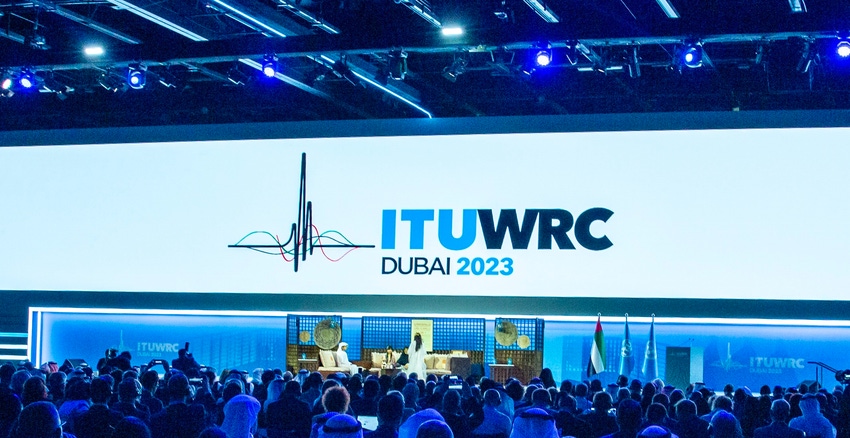6GHz, satellites and 6G addressed at WRC-23
ITU policymakers at the World Radiocommunication Conference set aside the 6.425-7.125GHz band for licensed mobile operations including 5G. It's a win for associations like GSMA, but US users may never see 5G in that band.

An international gathering of spectrum policymakers announced decisions on several hot topics, including opening a portion of the 6GHz band for 5G.
The International Telecommunication Union (ITU) made the move at its quadrennial World Radiocommunication Conference (WRC-23), which started last month in Dubai, United Arab Emirates (UAE) and ended today. It is intended to harmonize spectrum usage across the world so that operators, equipment vendors and others can avoid international fragmentation and leverage global economies of scale.
The GSMA trade group cheered the WRC-23 decision to set aside 6.425-7.125GHz for licensed, mobile operations.
"The 6GHz band is the only remaining midband spectrum currently available to respond to the data traffic growth in the 5G-Advanced era," GSMA said in a statement. As the primary international organization representing the 5G industry, it has been pushing for 5G operations in the 6GHz band.
"The WRC-23 decision to harmonize the 6GHz band ... is a pivotal milestone, bringing a population of billions of people into a harmonized 6GHz mobile footprint. It also serves as a critical developmental trigger for manufacturers of the 6GHz equipment ecosystem," GSMA explained.
The US angle
However, the decision at WRC-23 may not affect the US market. US regulators at the FCC in 2020 reserved the entire 6GHz band for Wi-Fi and other unlicensed operations, over the objections of the 5G industry.
"If the United States doesn't present alternative frequency ranges for 5G services that can be internationally harmonized, 5G operations in the 6GHz band could be adopted in more regions. This would allow Chinese equipment to proliferate in regions where the plan is adopted, setting back efforts to make Wi-Fi 6 in the band an international standard," warned Jeffrey Westling, director of technology and innovation policy at the American Action Forum US nonprofit, in a post published prior to the start of WRC-23.
Jessica Rosenworcel, chairwoman of the FCC, cheered the WRC-23's work. "The WRC was not just weeks of work in Dubai, but also years of preparation by the FCC, experts across the government, and our telecommunications industry," she said in a statement. "The delegation’s accomplishments will promote innovation in unlicensed spectrum including Wi-Fi, support 5G connectivity, pave the way for 6G, and bolster US leadership in the growing space economy. We now look forward to getting to work on preparations for WRC-27."
Interestingly, the Wi-Fi Alliance, a US trade group designed to promote the technology in unlicensed bands, also cheered the new 6GHz decision at the WRC-23. The association supported the FCC's decision to allocate the entire 6GHz band for unlicensed operations.
"The conference adopted an international treaty provision to explicitly recognize that this spectrum is used by wireless access systems such as Wi-Fi," the Wi-Fi Alliance said in a statement about the WRC-23 decision on 6GHz. The Wi-Fi Alliance noted that WRC-23 identified the 6GHz band for licensed operations in Europe, Africa and a few other countries, but not globally.
Space and satellites
According to the ITU, WRC-23 attendees agreed to a number of topics affecting the satellite industry. They also moved forward on regulations that would allow mobile devices to connect directly to satellites.
For example, the ITU said it will study "possible new allocations to the mobile-satellite service for direct connectivity between space stations and mobile user equipment to complement terrestrial mobile network coverage."
However, WRC-23 attendees essentially agreed to stall on one proposal that would review satellite power limits designed to avoid signal interference between different orbits. According to SpaceNews, newer players including SpaceX and Amazon argued that those Equivalent Power Flux Density (EPFD) rules were outdated. Now, those companies will have to wait until 2031 for regulatory action on the issue.
But they may be OK with that. "The Alliance for Satellite Broadband is pleased with the decision at this year's World Radio Conference to officially invite studies of EPFD limits and report the results to the next WRC in 2027," the association wrote in a statement. Amazon, which is pursuing a satellite constellation through its Project Kuiper effort, is a primary backer of the alliance.
"This is a win for innovation, enabling ITU members to evaluate the EPFD limits in light of modern satellite systems and spectrum management techniques. International regulators have taken a vital step toward revisiting these outdated rules by committing to these studies," the satellite association added.
6G
Finally, WRC-23 attendees also moved forward on the topic of 6G. That's not a surprise considering that, prior to the start of WRC-23, the ITU adopted a resolution intended to guide the development of a 6G standard.
During the conference, regulators agreed to study the 7-8.5GHz band for 6G in time for the next ITU conference in 2027. That spectrum band aligns with proposals from Ericsson and others for early 6G operations to sit between 7 GHz and 20 GHz.
"This global agreement [on the 7-8.5GHz band] ensures the ongoing growth of 5G around the world and paves the way for 6G from 2030 onwards," wrote the Global mobile Suppliers Association (GSA) in a statement. "Technical work now starts to determine the sharing and compatibility of 6G with incumbent uses of the identified spectrum."
"The entire global mobile ecosystem can now innovate with confidence and a clear sense of the spectrum requirements for 6G, both in terms of its future availability and compatibility with other users of the spectrum," argued Joe Barrett, president of the GSA, in the statement.
About the Author(s)
You May Also Like




_International_Software_Products.jpeg?width=300&auto=webp&quality=80&disable=upscale)







